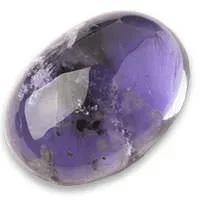 Iolite is a variety of the mineral cordierite. This mineral was named after French geologist Cordier. The name iolite comes from ios, the Greek word for violet. Iolite is commonly known as "water
Iolite is a variety of the mineral cordierite. This mineral was named after French geologist Cordier. The name iolite comes from ios, the Greek word for violet. Iolite is commonly known as "water ![]() sapphire" in its deep blue sapphire color. Like sapphire and tanzanite, its fellow blue gemstones, iolite is pleochroic- meaning it transmits light differently when viewed from different directions. The Vikings made iolite's pleochroism a virtue by using thin slices of the stone as a light polarizer to navigate their trips. By observing the sky through iolites, the Viking navigators were able to locate the exact position of the sun on overcast days. Iolite does what a Polaroid does- it cancels out haze, mist, and clouds to make things appear clearer. In fact, the stone has been called the "Viking's Compass." Only officially named in 1912, iolite has been used and admired for centuries. It was very popular in jewelry in the 18th Century in Europe but today it is used somewhat infrequently.
sapphire" in its deep blue sapphire color. Like sapphire and tanzanite, its fellow blue gemstones, iolite is pleochroic- meaning it transmits light differently when viewed from different directions. The Vikings made iolite's pleochroism a virtue by using thin slices of the stone as a light polarizer to navigate their trips. By observing the sky through iolites, the Viking navigators were able to locate the exact position of the sun on overcast days. Iolite does what a Polaroid does- it cancels out haze, mist, and clouds to make things appear clearer. In fact, the stone has been called the "Viking's Compass." Only officially named in 1912, iolite has been used and admired for centuries. It was very popular in jewelry in the 18th Century in Europe but today it is used somewhat infrequently.
 Nowadays, cordierite, the mineral which iolite comes from, also has industrial uses. It is used as an electrical insulator and in heating implements. Iolite is used to commemorate the 21st wedding anniversary and overall is an abundant and therefore reasonably priced gem. Iolite is renowned for its pleochrism, appearing intense blue in one direction, yellowish grey or blue in another, and becoming almost colorless as the stone is turned to the third direction. Iolite cannot be heated to improve its color or clarity. It occurs as short, prismatic crystals, which are normally gray, light or dark blue, or violet, but can also be yellowish gray. It is not very lustrous, but when transparent, has vitreous luster. The stone rates a 7-71/2 on the hardness scale and while it may look like a
Nowadays, cordierite, the mineral which iolite comes from, also has industrial uses. It is used as an electrical insulator and in heating implements. Iolite is used to commemorate the 21st wedding anniversary and overall is an abundant and therefore reasonably priced gem. Iolite is renowned for its pleochrism, appearing intense blue in one direction, yellowish grey or blue in another, and becoming almost colorless as the stone is turned to the third direction. Iolite cannot be heated to improve its color or clarity. It occurs as short, prismatic crystals, which are normally gray, light or dark blue, or violet, but can also be yellowish gray. It is not very lustrous, but when transparent, has vitreous luster. The stone rates a 7-71/2 on the hardness scale and while it may look like a ![]() sapphire, it is not as durable.
sapphire, it is not as durable.
 Most iolite stones are a few carats in weight, not too small, therefore, but not too large. Iolite's are commonly cut in faceted shapes and are never imitated or produced synthetically. Iolite can be found scattered in silica and alumina-rich igneous rocks. However it is mainly found in larger crystals, in schists and areas of metamorphism. The stone is also found in alluvial deposits as small, transparent, waterworn pebbles in Sri Lanka, Myanmar, and India. Other places include Namibia, Tanzania and the Northwest territories of Canada. Crystals are found in Germany, Norway, and Finland, Madagascar, the United States, Tanzania, Zimbabwe and Brazil.
Most iolite stones are a few carats in weight, not too small, therefore, but not too large. Iolite's are commonly cut in faceted shapes and are never imitated or produced synthetically. Iolite can be found scattered in silica and alumina-rich igneous rocks. However it is mainly found in larger crystals, in schists and areas of metamorphism. The stone is also found in alluvial deposits as small, transparent, waterworn pebbles in Sri Lanka, Myanmar, and India. Other places include Namibia, Tanzania and the Northwest territories of Canada. Crystals are found in Germany, Norway, and Finland, Madagascar, the United States, Tanzania, Zimbabwe and Brazil.
 Legends describe iolite as a way to strengthen one's eyesight. There are also many emotional attributes to the stone. Iolite has been said to enhance curiosity and achievement, guiding one through spiritual growth. It has also been said to overcome co-dependency with a partner. It brings friendliness and higher, purer thoughts, promotes charity and helpfulness. The stone awakens our hunger for the love of our whole self, aiding in accepting ourselves. Once we can accept ourselves truly, we come to understand that our level of self-acceptance reflects in our relationships with others. In terms of taking care of your iolite, do not use a steamer or ultrasonic cleaner on it. It is also important to avoid exposure of the stone to any type of chemicals, heat, or scratches. The best way to clean your iolite is using a solution of mild dish soap, warm water, and a soft brush.
Legends describe iolite as a way to strengthen one's eyesight. There are also many emotional attributes to the stone. Iolite has been said to enhance curiosity and achievement, guiding one through spiritual growth. It has also been said to overcome co-dependency with a partner. It brings friendliness and higher, purer thoughts, promotes charity and helpfulness. The stone awakens our hunger for the love of our whole self, aiding in accepting ourselves. Once we can accept ourselves truly, we come to understand that our level of self-acceptance reflects in our relationships with others. In terms of taking care of your iolite, do not use a steamer or ultrasonic cleaner on it. It is also important to avoid exposure of the stone to any type of chemicals, heat, or scratches. The best way to clean your iolite is using a solution of mild dish soap, warm water, and a soft brush.